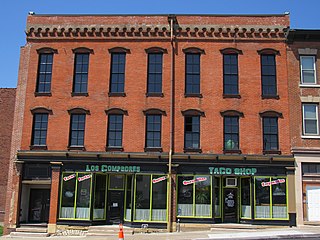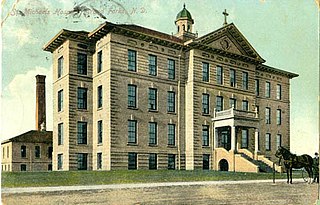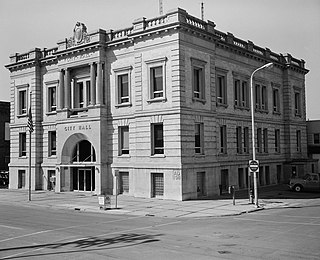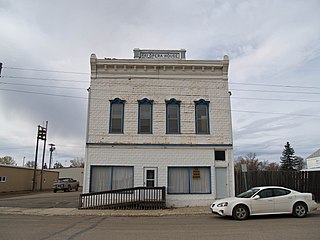
Ellendale is a town in Sussex County, Delaware, United States. The population was 381 at the 2010 census, an increase of 16.5% since 2000. It is part of the Salisbury, Maryland-Delaware Metropolitan Statistical Area. Ellendale is the "Gateway to Delaware's Resort Beaches" because it is the town located on U.S. Highway 113, the resort area's westernmost border, and Delaware Route 16, the resort area's northernmost border with the eastern border being the Delaware Bay and Atlantic Ocean and the southern border being the state line with Maryland.

The Dakota, also known as the Dakota Apartments, is a cooperative apartment building on the northwest corner of 72nd Street and Central Park West in the Upper West Side of Manhattan in New York City, United States. The Dakota was constructed between 1880 and 1884, and was designed by Henry Janeway Hardenbergh.

Maybury Hill is a historic house at 346 Snowden Lane, in Princeton, Mercer County, New Jersey, United States. Built about 1725, it was the birthplace and boyhood home of Joseph Hewes (1730-1799), a signer of the United States Declaration of Independence. The house, an architecturally excellent example of Georgian domestic architecture, was designated a National Historic Landmark in 1971 for its association with Hewes. It is a private residence not open to the public.

The Menlo Avenue–West Twenty-ninth Street Historic District is a historic district in the North University Park neighborhood of Los Angeles, which is itself part of the city's West Adams district. The area consists of late Victorian and Craftsman-style homes dating back to 1896. The area is bounded by West Adams Boulevard on the north, Ellendale on the east, West Thirtieth Street on the south, and Vermont Avenue to the west. The district is noted for its well-preserved period architecture, reflecting the transition from late Victorian and shingle-styles to the American Craftsman style that took hold in Southern California in the early 1900s. The district was added to the National Register of Historic Places in 1987.

The Newport Opera House is a historic civic building and performing arts venue at 20 Main Street in the heart of downtown Newport, the county seat of Sullivan County, New Hampshire, United States. Built in 1886, it was billed as having the largest stage in New England north of Boston, and continues to serve as a performance venue today. The building was listed on the National Register of Historic Places, as "Town Hall and Courthouse", in 1980, for its architecture and civic roles, and is a contributing property in the Newport Downtown Historic District.

The Osborne, also known as the Osborne Apartments or 205 West 57th Street, is an apartment building at Seventh Avenue and 57th Street in Midtown Manhattan in New York City. The Osborne was originally designed by James Edward Ware and constructed from 1883 to 1885. An annex to the west, designed by Alfred S. G. Taylor and Julien Clarence Levi, was constructed in 1906. The Osborne is the second oldest luxury apartment building in New York City, behind the Dakota.

The Wupperman Block/I.O.O.F. Hall is a historic building located just north of downtown Davenport, Iowa, United States. It was individually listed on the National Register of Historic Places in 1983. In 2020 it was included as a contributing property in the Davenport Downtown Commercial Historic District.

The Burtis–Kimball House Hotel and the Burtis Opera House were located in downtown Davenport, Iowa, United States. The hotel was listed on the National Register of Historic Places in 1979. It has since been torn down and it was delisted from the National Register in 2008. The theatre building has been significantly altered since a fire in the 1920s. Both, however, remain important to the history of the city of Davenport.

Dibley House, also known as Graf House, is a property in Fargo, North Dakota that was listed on the National Register of Historic Places in 1980. The listing included two contributing buildings on an area of less than 1 acre (0.40 ha).The listing included two contributing buildings on an area of less than 1 acre (0.40 ha).

George Hancock was an architect active in North Dakota, Montana and Minnesota.

Dinnie Apartments is a building in Grand Forks, North Dakota that was listed on the National Register of Historic Places (NRHP) in 1994. Dinnie Apartments is included in the Grand Forks Near Southside Historic District, which was listed on the NRHP in 2004.

The First National Bank is a five-story building in Grand Forks, North Dakota, that was built in 1914–15 and listed on the National Register of Historic Places in 1982. It was built for the Scandinavian-American Bank, but has been identified as the First National Bank building since 1929.

The Larimore City Hall is a building in Larimore, North Dakota that was listed on the National Register of Historic Places in 1990. It "may be described as a two-and-a-half story rectangular structure of red-painted buff brick which rises to a hipped roof."

John W. Ross (1848–1914) was the first licensed architect in Grand Forks, North Dakota.

The Dickey County Courthouse in Ellendale, North Dakota was built in 1910. It is in Beaux Arts architecture and was designed by architects Buechner & Orth. It was listed on the National Register of Historic Places (1980) in 1980.

The Alfred and Clara Sevareid House on 2nd St., W., in Velva, North Dakota was built in 1913. It was listed on the National Register of Historic Places in 1996.

The Thomas Nichols Putnam House on Main St. in Carrington, North Dakota, United States, is an American Foursquare house with Classical Revival architecture elements that was built in 1907. It was listed on the National Register of Historic Places in 1992.

Ray Opera House is on Main Street in Ray, North Dakota.

The Lisbon Opera House is a historic building in Lisbon, North Dakota.
George Issenhuth (1862–1941) was an American architect based in South Dakota. He designed several buildings which have been listed on the National Register of Historic Places (NRHP).






















